Children with anxiety often face challenges in handling stress, fear, and overwhelming emotions. Parents can feel unsure how to help their children manage these challenging moments. One effective way to support children with anxiety is through pediatric occupational therapy. Therapists use a variety of tools, such as deep-pressure activities and sensory techniques, to help children cope with stress. These methods calm children and teach them long-term skills to manage their feelings better.
Pediatric occupational therapy focuses on giving children with anxiety practical ways to handle stress. Through exercises that engage the senses, like proprioception and vision-based activities, therapists guide children in controlling their reactions to triggers. Over time, these strategies help children build resilience and reduce the impact of anxiety in their daily lives.
Key Takeaways
- Pediatric occupational therapy utilizes sensory-based coping strategies to help children manage anxiety, including proprioception and vision-based methods.
- Therapy sessions incorporate relaxation exercises, skill-building activities, and sensory-based interventions to address sensory processing issues contributing to anxiety.
- Sensory overload and dysfunctions are managed through techniques like Sensory Integration and Emotional Regulation, reducing overall anxiety reactions.
- Teaching sensory-based skills such as deep breathing, muscle relaxation, and mindfulness practices enhances self-regulation and resilience in children.
- Occupational therapy provides a supportive environment for children to develop coping strategies and resilience. It offers resources for identifying triggers and a tailored approach for empowerment.
Understanding Pediatric Occupational Therapy
With a plethora of therapeutic strategies at their disposal, pediatric occupational therapists play a pivotal role in assisting children to navigate the often tumultuous waters of anxiety. This occupational therapy branch equates children with coping mechanisms and sensory tools to manage stress, enhance self-esteem, and improve holistic functioning. Many of these therapists specialize in managing conditions like Sensory Processing Disorder, which can often coexist with anxiety in children.
Occupational therapists adopt a holistic approach that addresses a child’s emotional, social, and sensory needs. This all-encompassing perspective, which may include creating a sensory-friendly environment, ensures a comprehensive intervention strategy that targets the core causes of anxiety rather than simply addressing the symptoms.
Therapy sessions typically incorporate relaxation exercises, sensory-based interventions, and skill-building activities. These diverse techniques are designed to empower children, teaching them how to handle anxiety-inducing situations confidently. Sensory tools, for instance, can offer a concrete method for children to self-regulate their emotions, thus fostering autonomy and resilience.
The ultimate aim of pediatric occupational therapy is to enable children to thrive in their daily lives despite the challenges of anxiety. By instilling these coping mechanisms, therapists provide children with a lifelong toolkit for managing stress, promoting mental well-being, and supporting their overall development.
Occupational Therapy’s Role in Anxiety
Occupational therapy illuminates a beacon of hope for children grappling with anxiety, playing a significant role in their journey toward mental stability. By teaching coping mechanisms and utilizing sensory tools, such as weighted blankets for deep pressure and muscle relaxation, occupational therapy equips children with the skills to manage stress and regulate their feelings effectively.
Sensory-based interventions have become a crucial component of occupational therapy. They address sensory processing issues, which often contribute to a child’s anxiety. Occupational therapy promotes self-regulation and emotional well-being by helping children recognize and manage signs of stress and introducing techniques like auditory processing activities.
Furthermore, occupational therapy uplifts children’s confidence. With each learned skill, they become better equipped to navigate anxiety-inducing situations. This progress, in turn, reduces their anxiety symptoms, instilling a sense of control and serenity.
Occupational therapy’s focus is not only on symptom management but also on fostering resilience. It enables children to confront their anxiety directly, providing them with the tools to manage their emotional well-being. The compassionate support and strategic interventions of occupational therapy serve as essential lifelines for children suffering from anxiety, offering hope for a stable, anxiety-free future.
Recognizing Anxiety in Children
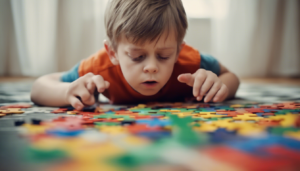
In the labyrinth of childhood feelings, anxiety often cloaks itself in symptoms that might seem familiar or unrelated. Recognizing anxiety in children requires a keen understanding of how these symptoms manifest distinctively in younger populations. Some children may exhibit signs resembling early symptoms of ADHD, such as fidgeting or difficulty focusing, which can be related to anxiety but may also indicate Sensory Processing Disorder. Conventional signs such as tantrums, avoidance behavior, headaches, and difficulty concentrating could be early indications of anxiety. These symptoms may affect a child’s academic performance and social interactions as they grapple with overwhelming worry or dread.
Identifying symptoms of anxiety doesn’t just involve noticing overt behavior but also understanding the child’s mental state and physical discomfort. This knowledge aids caregivers and therapists in implementing effective coping strategies tailored to address the child’s specific needs and helps manage any potential sensory challenges. It allows for the creation of supportive environments that can foster emotional growth and resilience.
Sensory Overload and Anxiety
Traversing the turbulent waters of sensory overwhelm can significantly heighten anxiety in children, particularly those struggling with sensory processing issues. When stimuli in the surroundings flood a child’s sensory system, the outcome is often sensory overwhelm. This overwhelm can result in intensified anxiety reactions, including distress and meltdowns, and can impact a child’s emotional management and behavior.
Occupational therapy plays a crucial role in assisting children in developing coping strategies to handle sensory overwhelm and alleviate anxiety symptoms. By offering a structured, safe, and supportive setting, occupational therapists can lead children through diverse sensory encounters, aiding them in navigating their responses and feelings effectively.
To grasp this better, consider the following table:
| Factor | Impact | Therapy Approach |
|---|---|---|
| Sensory Overload | Increased Anxiety Reactions | Sensory Integration Therapy |
| Emotional Management | Challenges in Processing Sensory Information | Emotional Regulation Therapy |
| Coping Techniques | Diminished Anxiety Symptoms | Cognitive Behavioral Therapy |
This all-encompassing approach ensures that children not only learn to control sensory overwhelm but also enhance emotional regulation, lessening their overall anxiety reactions.
Addressing Sensory Dysfunctions
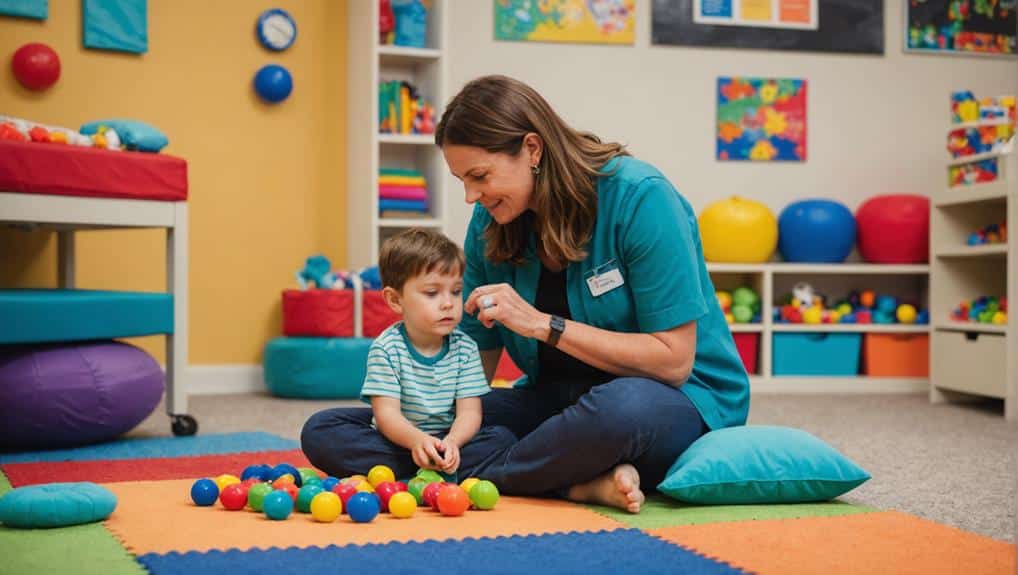
Shifting our focus to another essential facet of pediatric occupational therapy, we explore sensory dysfunctions. Sensory dysfunctions in children with anxiety can lead to heightened sensitivity or enthusiastic seeking of sensory experiences. Occupational therapy provides a valuable service in this landscape, incorporating sensory-based interventions, such as Sensory Integration Therapy, to help children manage their sensory needs effectively.
- Deep pressure exercises: These exercises, often integrated into occupational therapy, minimize sensory triggers in anxious children. By providing proprioceptive input, they can aid in calming the child’s nervous system. Occupational therapists also utilize specific equipment for these exercises to target different sensory systems.
- Environmental modifications: Occupational therapists create sensory-friendly environments to reduce potential triggers and promote safety and comfort. This is particularly crucial in settings where children with Sensory Processing Disorders may often struggle without suitable accommodations.
- Calming activities: These carefully designed activities contribute to sensory input regulation, helping reduce sensory overload and foster tranquility.
- Overall well-being: By systematically addressing sensory dysfunctions, occupational therapy aids children in regulating their sensory experiences, consequently enhancing their general well-being.
The empathetic and detail-oriented approach of occupational therapists, combined with their knowledge of sensory dysfunctions and interventions, proves pivotal in supporting children with anxiety. This, without a doubt, highlights the significance of occupational therapy in the lives of these children.
Sensory-Based Coping Strategies
Sensory-based coping strategies are critical tools in pediatric occupational therapy for children grappling with anxiety. These strategies, often utilized by occupational therapists in Sensory Integration Therapy, assist children with self-regulation and response to sensory stimuli. Proprioception-based methods, such as chewing gum or hand clenching, help children self-regulate their feelings, while vision-based techniques, like watching lava lamps or glitter wands, deliver calming visual stimuli. In addition, these sensory therapy techniques can improve a child’s focus and participation in school and social settings. Furthermore, the process of teaching these skills not only provides immediate stress relief but also equips children to recognize their stress signals and prepare for new situations.
Proprioception-Based Coping Methods
Proprioception, the perception of self-movement and body position, is vital in managing anxiety in children. Pediatric occupational therapy utilizes proprioception-based coping methods to assist children in self-regulation and reduce anxiety levels. These strategies are pivotal in managing the impact of conditions like Sensory Processing Disorder, which can disrupt sensory processing and affect a child’s perception and skill development.
These methods include activities that offer deep pressure input and a sensory experience that can be calming. For instance:
- Knee tapping, muscle squeezes, and hand clenches can help children become more conscious of their bodies and movements, fostering a sense of control.
- Sensory touch bars can be attached to desks, providing tactile stimulation and a focal point during stressful times.
- For oral sensory input, children can chew gum or engage in soothing water bead sensory play, which can assist in managing anxiety.
- Deep pressure input, like bear hugs or weighted blankets, can also be particularly advantageous in reducing anxiety levels. Tailored approaches like those used in managing SPD are fundamental in addressing each child’s needs and experiences.
Vision-Based Coping Techniques
Another effective therapeutic intervention, building on proprioception-based coping methods, involves using vision-based coping techniques. This approach can be constructive for children dealing with anxiety, as it engages their visual senses and aids in relaxation and regulation of feelings.
Visual tools such as lava lamps or glitter wands can calm children, helping them refocus and reduce their stress levels. The tranquil, slow-moving visuals distract from overwhelming stimuli, promoting a sense of calm and peace. The gentle shifts in color and light can draw a child’s focus away from their anxiety, creating a soothing atmosphere that relieves stress.
Teaching Sensory-Based Skills
Teaching sensory-based skills is a crucial strategy among the diverse therapeutic approaches for managing childhood anxiety. These skills serve as calming coping mechanisms, allowing children to self-regulate their emotions and respond to stress signals healthily.
- Knee tapping and muscle squeezes are simple, physical, sensory-based skills that help children manage their anxiety. They provide a soothing rhythm, physical release, and emotional outlet for stress.
- Sensory touch bars and puffer balls: These tools provide tactile stimuli that can comfort children during stressful situations. The sensory touch bars on desks offer a discreet coping mechanism at their fingertips.
- Hand clenches and calming water bead sensory play promote relaxation by engaging the senses and distracting the mind from anxiety-inducing thoughts.
- Vision-based strategies, such as lava lamps or glitter wands, engage the child’s attention and calm their mind, reducing their anxiety levels.
Teaching sensory-based skills involves identifying stress signals, practicing these strategies, and preparing children to handle overwhelming situations. Uplifting our children with these skills offers them a sense of control and confidence in their path toward managing anxiety.
Teaching Kids Coping Skills
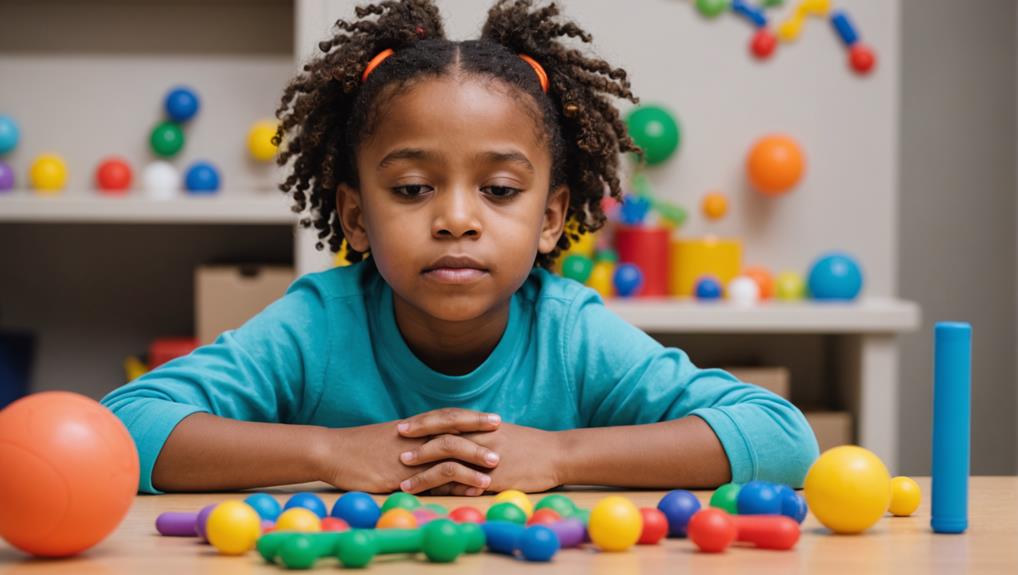
In pediatric occupational therapy, equipping children with practical coping skills plays a significant role. This process begins by identifying a child’s stress signals and environmental triggers, which are often distinct from each child’s experience of anxiety. Occupational therapists then utilize role-playing techniques, simulating potentially overwhelming situations to enable children to practice and develop coping skills.
Sensory strategies are vital tools often employed in teaching coping skills. These can include actions such as muscle squeezes or chewing gum. Sensory-based coping skills not only help manage immediate anxiety but also contribute to the child’s long-term ability to deal with stressors independently.
One of the most empowering aspects of occupational therapy is its focus on tailoring coping skills based on a child’s unique stress signals. This customization fosters a sense of ownership and autonomy in children, enabling them to manage their anxiety more effectively. In this way, the child is not merely a passive recipient of therapy but an active participant in their progress towards handling anxiety.
Importance of Sensory-Based Skills
In pediatric occupational therapy, sensory-based skills are a significant tool in assisting children with anxiety. Sensory tools and coping techniques not only help these children understand and manage their sensory inputs but also offer a means of self-regulation during moments of heightened anxiety. The acquisition and application of these skills can substantially improve emotional well-being, stress reduction, and general functioning, thereby underscoring their critical importance.
Sensory Tools for Anxiety
Exploring the world of anxiety can be a challenging task for many children, but sensory tools provide a practical and effective path to the regulation of feelings. These tools, customized to address unique stress signals, equip children with anxiety to manage overwhelming emotions through sensory-based coping strategies.
Incorporating sensory tools into a child’s routine can reduce anxiety symptoms in several ways:
- Proprioception-based tools, such as muscle squeezes and hand clenches, provide calming sensory input. These tools can help children ground themselves during moments of heightened stress.
- Vision-based tools, like lava lamps and glitter wands, offer visual stimulation that promotes relaxation. By focusing on these tools, a child can distract themselves from challenging stimuli.
- Tactile tools like stress balls or fidget spinners can offer immediate physical feedback, helping kids channel their nervous energy.
- Auditory tools, soothing sounds, or music can induce calmness and reduce stress.
Teaching Coping Techniques
Moving beyond the use of sensory tools, it’s just as essential to equip children struggling with anxiety with practical coping techniques. Sensory-based coping skills are integral to this process, enabling children to effectively manage overwhelming feelings and reduce stress.
Teaching coping techniques like deep breathing and muscle compressions gives children a practical method for regulating emotions. These sensory-based skills give them the tools to recognize and respond to stress signals healthily, reducing anxiety and enhancing overall well-being.
Deep breathing techniques, for example, can help children slow down their racing thoughts and stabilize their heartbeat. On the other hand, muscle compressions are a physical way of grounding anxiety, releasing tension, and promoting a sense of calm.
Benefits of Sensory Skills
Utilizing the strength of sensory-based skills, children with anxiety can learn to manage their emotions and navigate stress effectively. These skills equip children to identify and adequately respond to sensory triggers, thereby lessening their anxiety levels. Sensory skills are not just tools for managing symptoms; they are enabling coping mechanisms that will allow children to take control of their emotions and reactions to anxiety triggers.
- Stress Management: Sensory-based skills are instrumental in teaching children with anxiety how to handle stress effectively. Children can anticipate and better react to situations that might cause anxiety by identifying sensory triggers.
- Self-Regulation: Developing sensory coping mechanisms empowers a child’s ability to self-regulate. This can lead to greater independence and confidence in their ability to handle anxiety symptoms.
- Reduced Anxiety Levels: Sensory skills help children understand and manage their responses to anxiety triggers, leading to decreased anxiety levels over time.
- Empowerment: Sensory-based skills give children control over their emotions and reactions, leading to a comprehensive understanding of empowerment.
Collaborative Approach to Coping Strategies
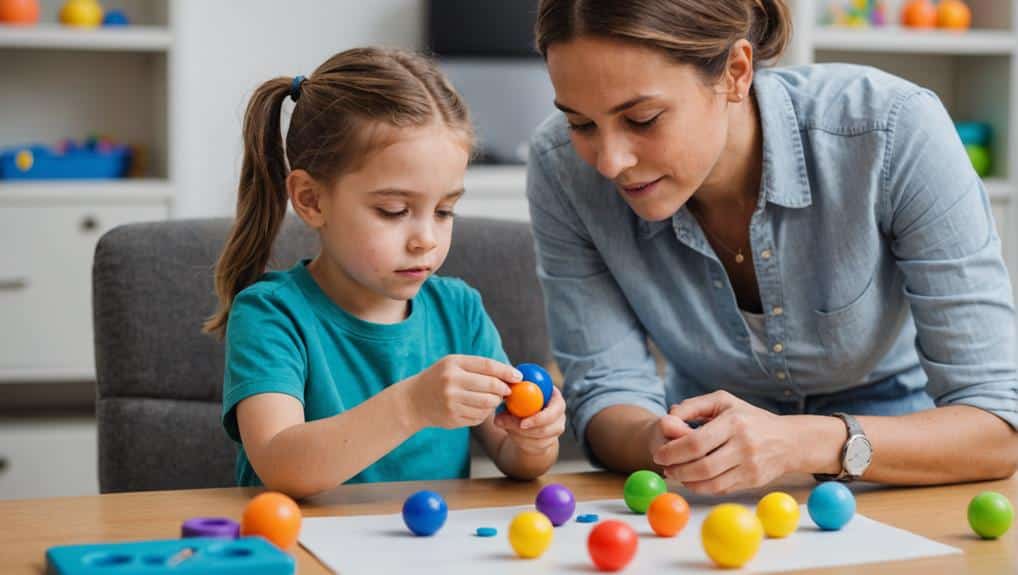
In pediatric occupational therapy, one essential method for supporting children with anxiety is the cooperative approach to coping strategies. This method encourages children to actively engage in their anxiety management by creating tailored techniques that they find most useful. The approach promotes a sense of independence and strength, crucial elements in the long-term management of anxiety.
The cooperative approach revolves around open communication, allowing children to express their emotions and recognize stress signals. Occupational therapists collaborate closely with the children, guiding them toward understanding their emotional reactions and enabling them to utilize their coping strategies independently. This method teaches techniques and establishes a supportive and empathetic environment where children feel comfortable sharing their emotions and concerns.
Developing personalized coping strategies through collaboration can significantly enhance a child’s ability to handle stress effectively. Not only does it provide immediate relief from anxiety symptoms, but it also provides them with the tools to navigate future stressors. Therefore, the cooperative approach to coping strategies in pediatric occupational therapy offers a comprehensive and efficient way to assist children in managing their anxiety.
Resources for Sensory-Based Coping
Recognizing sensory triggers is a vital step in assisting children with anxiety in managing their emotions more effectively. We can provide tailored and efficient strategies that address specific needs using resources such as proprioception and vision-based coping tools. These tools support immediate anxiety management and equip children with lifelong skills for emotional regulation and resilience.
Identifying Sensory Triggers
While it may seem surprising, sensory stimuli like loud sounds, intense lights, challenging textures, or crowded areas can significantly contribute to anxiety in children. Each child’s sensory stimuli may vary, making it vital to observe and communicate with them to identify these specific stimuli. This awareness enables pediatric occupational therapists to customize coping strategies to unique needs, ensuring that each child receives tailored strategies to handle their anxiety effectively.
Here are four key points to keep in mind:
- Sensory stimuli can vary from auditory to visual, tactile, or environmental elements. Recognizing these can assist in developing effective coping strategies.
- Tailored strategies are essential as each child experiences sensory stimuli differently. What may be soothing for one child could be overwhelming for another.
- Sensory tools like fidget toys, weighted blankets, or sensory bins can help children self-regulate emotions and reduce anxiety.
- Understanding sensory stimuli allows for a hands-on approach to managing anxiety, creating calming environments that cater to each child’s sensory requirements.
Effective Coping Tools
An abundance of sensory-based coping aids are available to assist children with anxiety in managing their stress cues and triggers. Occupational therapy plays a crucial role in teaching these methods, which include proprioception-based techniques like knee tapping and muscle squeezes. These tactile approaches enable children to regain their sense of control, thereby reducing anxiety levels.
Vision-oriented coping aids like bubble tubes or glitter sticks can help children handle overwhelming emotions. These objects’ calming, gentle movements can offer a soothing visual stimulus, redirecting their focus from the origin of anxiety.
It’s essential to understand that these are not one-size-fits-all solutions. Sensory-based coping aids can be customized to meet the individual needs of each child, offering tailor-made strategies for effectively managing anxiety. By discussing stress cues, pinpointing triggers, and practicing these coping aids, children can achieve long-term success in emotional growth. The ultimate aim is to equip them with the skills to navigate their anxiety independently, nurturing resilience and enhancing their confidence in dealing with stressful situations.
Empowering Kids With Strategies
Given the varied nature of anxiety symptoms in children, occupational therapy employs a range of sensory-based strategies to strengthen these young children. The aim is to equip kids with customized tools and coping strategies that aid in anxiety management. These strategies not only help children navigate their immediate feelings of stress but also foster long-term mental well-being.
- Physical Coping Strategies: Techniques like knee tapping and muscle squeezes provide a bodily outlet for stress, helping children manage anxiety.
- Visual Coping Aids: Lava lamps or glitter wands provide engaging visuals for relaxation and stress reduction.
- Stress Signal Recognition: Educating children on identifying their stress signals and triggers can enable them to take proactive steps when faced with overwhelming situations.
- Tailored Sensory Tools: Items like puffer balls and sensory touch bars are customized to each child’s specific needs, providing a tactile outlet for managing stress and anxiety.
Through these approaches, pediatric occupational therapy can offer an empowering platform for children to cope with anxiety, equipping them with the sensory tools they need to comprehend and manage their stress signals effectively.
Impact of Anxiety in Children
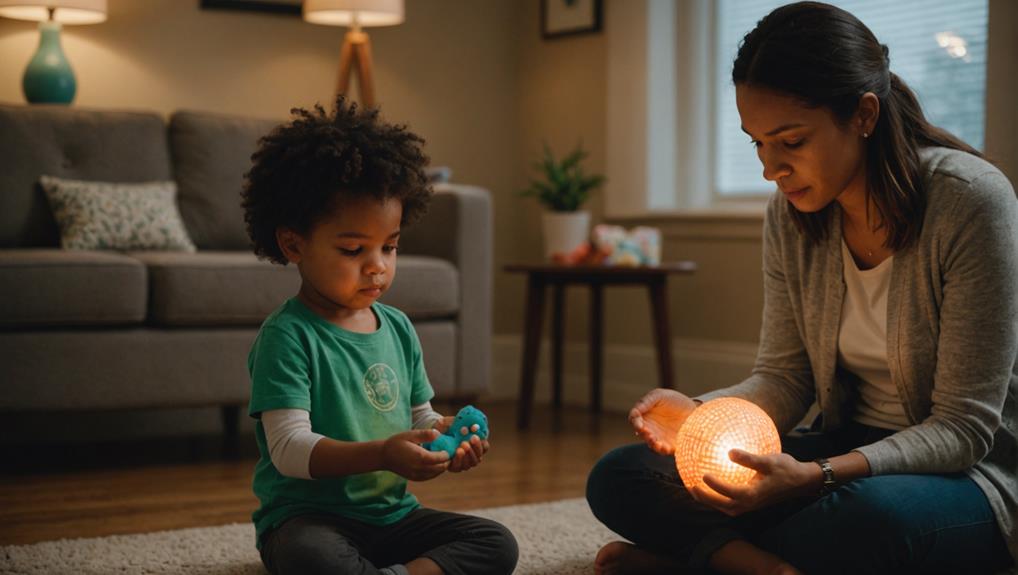
Recognizing the impact of anxiety on children has become an increasingly urgent concern. With about 10% of children aged 3-17 in the US affected, anxiety significantly influences their daily functioning. The symptoms, which include excessive worry, muscle tension, irritability, and poor sleep quality, can be debilitating, affecting their academic performance and social interactions.
For a child to be diagnosed with Generalized Anxiety Disorder (GAD), these symptoms must persist for at least six months. This prolonged distress underscores the importance of early recognition and support for these children. However, many children experience anxiety symptoms without a formal diagnosis, which can lead to undiagnosed and untreated symptoms.
Coping mechanisms and sensory tools in pediatric occupational therapy can play a crucial role in helping these children manage their anxiety and improve their daily functioning. These interventions aim to enable children to navigate their anxieties, providing them with strategies to manage their symptoms better. As we work to support the well-being of children affected by anxiety, understanding its impact is the foremost step towards more effective and compassionate interventions.
Occupational Therapy Interventions for Anxiety
Utilizing the power of occupational therapy interventions, therapists work to alleviate the debilitating effects of anxiety in children. These interventions focus on crafting individualized coping mechanisms tailored to meet each child’s needs and challenges.
Therapists employ a variety of sensory tools and thoughtful approaches to help children manage anxiety triggers and regulate their emotions effectively. This is achieved through a holistic process:
- Deep Breathing Techniques: This method promotes relaxation and stress relief, aiding children in controlling their responses to anxiety triggers.
- Progressive Muscle Relaxation: By gradually tensing and releasing different muscle groups, children learn to differentiate between states of tension and relaxation.
- Mindfulness Practices: These activities assist children in staying present, reducing concerns about the past or future.
- Sensory Processing Skills Training: This aids children in understanding and appropriately responding to sensory inputs, enhancing their emotional regulation abilities.
Through these interventions, occupational therapy not only alleviates anxiety symptoms but also enhances self-esteem among children. It equips them with skills to cultivate resilience, effectively cope with anxiety, and navigate life’s challenges more quickly and positively.
Frequently Asked Questions
How Does Occupational Therapy Help Children With Anxiety?
Pediatric occupational therapy aids children with anxiety by imparting coping mechanisms, enhancing sensory processing skills, and promoting the regulation of feelings. The treatment employs sensory-based interventions and relaxation exercises to manage anxiety triggers and symptoms effectively.
What Does an Occupational Therapist Do for a Child With Sensory Issues?
Pediatric occupational therapists create tailored sensory interventions for children with sensory issues. They employ sensory-based activities and tools while collaborating with parents and educators to establish sensory-friendly environments, enhancing daily functioning and reducing anxiety.
What Is the Role of Occupational Therapy in Anxiety Disorder?
Occupational therapy aids children with anxiety disorders by teaching coping strategies, enhancing regulation skills, and addressing sensory processing issues. This approach instills confidence and promotes effective management of stress and anxiety.
What Are Sensory-Based Interventions for Occupational Therapists?
Sensory-based interventions by occupational therapists involve utilizing sensory tools and activities, like deep pressure exercises and calming sensory tasks, to manage sensory irregularities and decrease anxiety symptoms in children.
Conclusion
The application of pediatric occupational therapy in managing anxiety in children highlights its crucial role in mental health. A remarkable statistic is that around 7% of children aged 3-17 years have been diagnosed with anxiety. Sensory-based interventions and coping strategies can significantly enhance emotional regulation, resilience, and general well-being. This holistic approach not only addresses immediate anxiety symptoms but also equips children with long-term mental health skills.

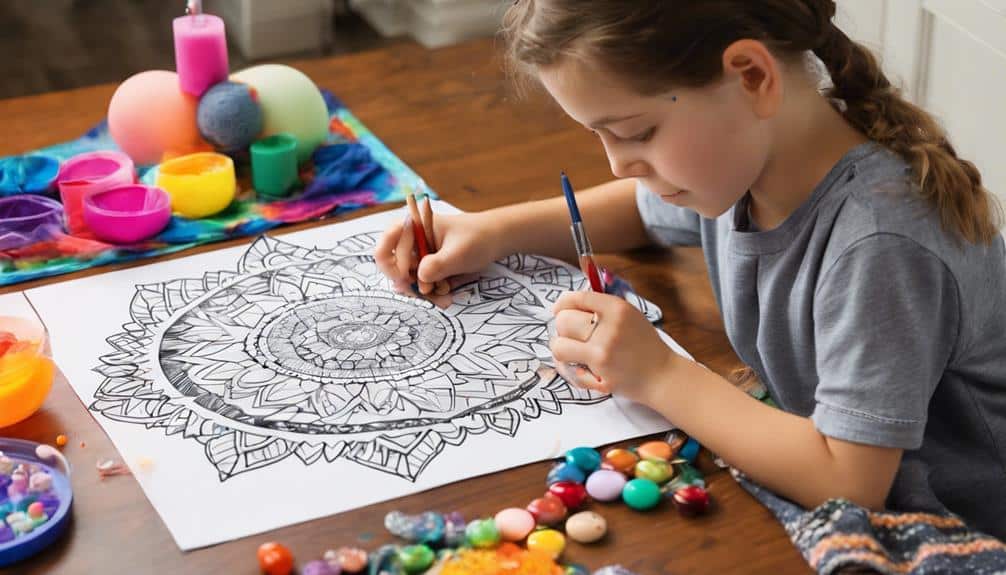
Recent Comments